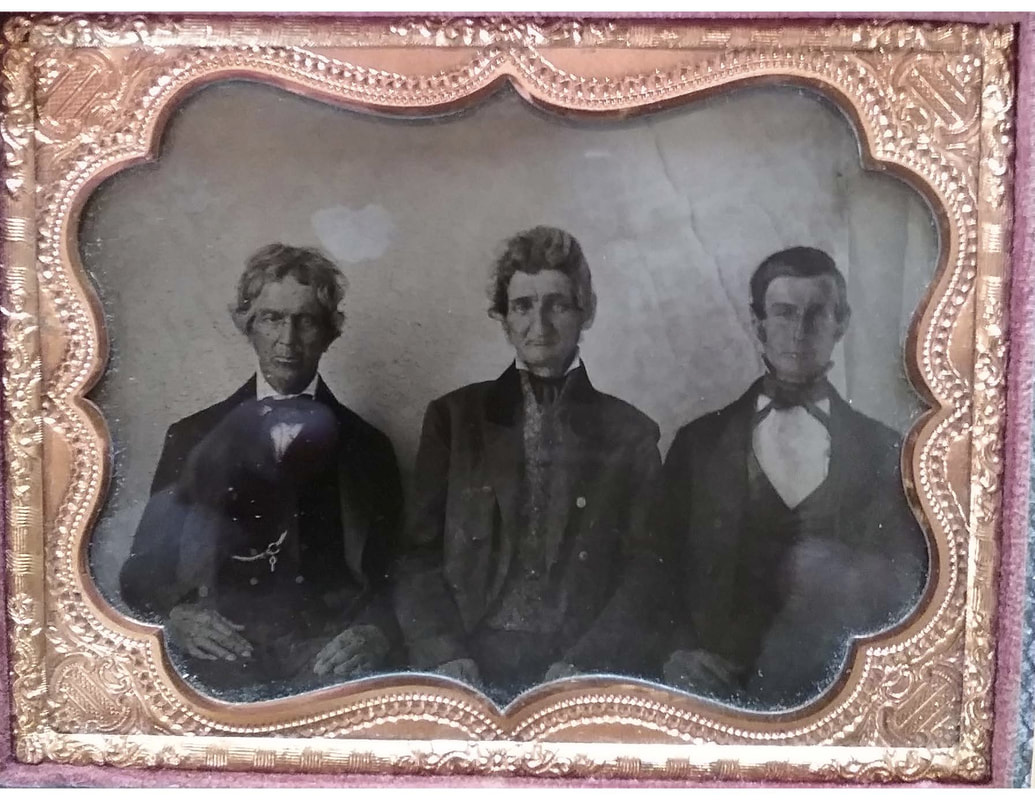|
Greetings from cold and wintery Easton! Snow blankets the ground and the coldest air in two years ensures its survival for a while. A winter storm is looming for Monday and Tuesday. Shovel Shop Pond is finally iced over, and a few people have been testing the ice near the shore in hopes of doing some skating this weekend.
Today’s historical photo is another rare one. One of Easton’s leading families is featured in this picture of a father with his two sons. George Washington Hayward (1807-1880) lived in the house at 227 Foundry Street that was built by his father Joseph Hayward in 1778. (This house replaced the first Joseph Hayward house, built on the same site sometime prior and moved to the rear of the lot when the new house was built). The Haywards were farmers and also cut timber, and were very successful. One of them, probably George, introduced hop growing to the farm, and their hops, dried in their own kiln, was much in demand from local beer brewers. Much of the land now occupied by the Southeastern Regional High School was used for hop growing. The house, with a large barn situated across Foundry Street, includes a wonderful “great room” and large fireplace, providing spacious living quarters for the growing Hayward family. Joseph, and his wife Sylvia nee Pratt (1812-1887) had fourteen children. One could see the need for more space! There was another need for space. During this period, Foundry Street from West Bridgewater ended at the Hayward farm, and on occasion, lost overnight travelers or wandering salesmen could find a warm bed and a meal there before being sent on their way in the morning. George W. Hayward eventually came into ownership of his father’s new house (the old house was destroyed by a violent gale in 1812). There he and Sylvia raised a smaller family of three children: daughter Georgiana (1835-1899), son Edward Russell (1837-1915), and son Dr. Joseph Warren Hayward (1841-1905). Later, son Edward and his wife Caroline (Belcher) would build 239 Foundry Street and continue in the farming business. Son Joseph and his wife Lemira (Drake) would move to Taunton where he conducted a successful medical practice for many years. Daughter Georgiana married J. Richard Hunt. At some time after the Civil War, George had his portrait taken with his two sons by an unknown photographer and at an unknown location. George is in the center of the photo, and at the left is son Edward, with the other son Doctor Joseph on the right. George was well known in Easton, serving the Town in several offices as well as being a leader in church. The photo, measuring about 3” x 4” is behind glass in a metal frame, and enclosed by a tooled leather case. A clipping from an unidentified newspaper is included in the photo case, and serves as an obituary for one of Easton’s best-known men. It reads as follows: “Capt. G. Washington Hayward, whose death was noted in these columns last week, was the seventh son of Joseph and Lydia (Barrows) Hayward, and a descendent of Thomas, who emigrated from Aylesworth, England, in 1635. He resided on the patrimonial estate inherited from his ancestors, formerly of the Taunton North Purchase, and the house is over a hundred years old, although improved. Capt. Hayward was in command of the Easton Company, sixty years ago, of the regiment and brigade of which his neighbor General Shepard Leach, had command. He was a member and chairman of the Board of Selectmen for many years; also a member of the Old Congregational Society, over which Rev. Dr. Sheldon ministered some fifty years. He is the last member of a family of fourteen, including seven brothers who were over six feet in height – the seven aggregating 43 feet. Capt. Hayward, during his years of farmer’s life, enjoyed the esteem of his townsmen. He leaves a widow, a daughter, and two sons, Edward R., a farmer in Easton, and Dr. Joseph W. Hayward, of Taunton.” On July 14, 1878, a Centennial Celebration was held at the house and adjoining field, where more than one hundred family members gathered. The keynote speaker was George himself, and the family later published the proceeds of the gathering. There is one other item that deserves mention. Among the artifacts in our collection is what appears to be a Tudor era window that came from the Hayward family’s ancestral home in England. It was brought here to Easton by one of the early Haywards and was installed in the old Joseph Hayward home. It is one of the oldest windows I know of in the area, and may date to the late 16th or very early 17th century. I hope to make contact with someone who can help me trace the family home in England, and perhaps gain more knowledge regarding the window and the home it came from. Much more can, and should, be written about this important Easton family that has direct descendants still living on what once was the family farm. Stay well, stay warm, and until next week, Frank
0 Comments
Your comment will be posted after it is approved.
Leave a Reply. |
Author
Anne Wooster Drury Archives
June 2024
Categories |
Easton Historical Society and Museum
PO Box 3
80 Mechanic Street
North Easton, MA 02356
Tel: 508-238-7774
[email protected]

